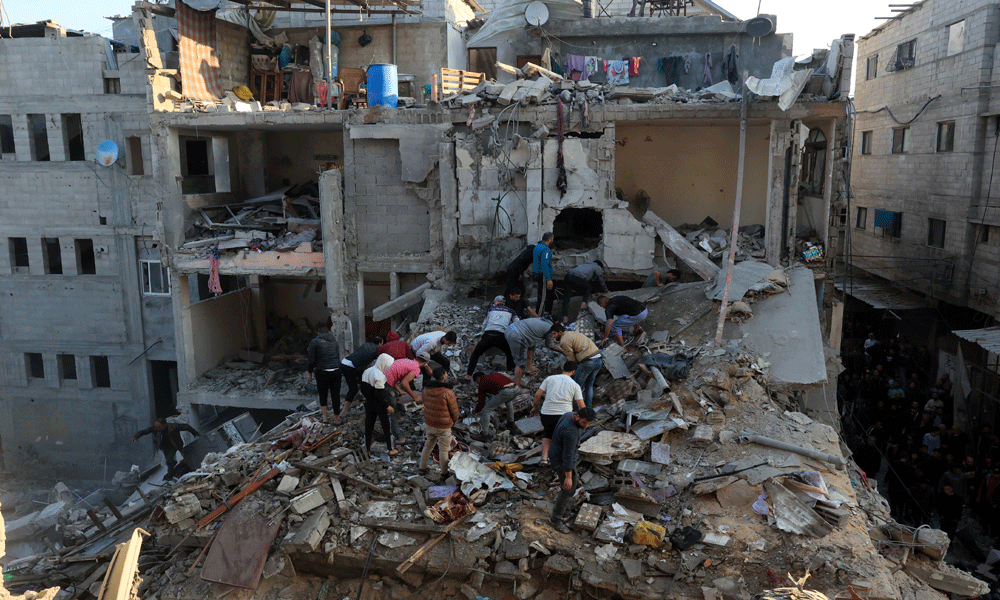Before it is officially inaugurated, the Federal Shariat Court has moved to new premises built at the Constitution Avenue.
This piece of beautifully erected and tastefully decorated edifice is located between the Auditor General's Complex and the National Election Commission.
The four-story building topped with proportionate some small and one main dome faces the Supreme Court of Pakistan that commands an appellate jurisdiction over it. The nation's highest judicial forum has a special bench to hear the appeals against the determinations of the FSC.
The common between the two buildings is the marble façade, but the material used on Federal Shariat Court is whiter, and has more fresher look than the court higher to it jurisdiction.
Large glass windows and panels that brighten the passages and the rooms with natural light inside also distinguish the angular building.
The glass used is tainted with light green colour, creating a soothing effect in corridors and stairs that rise around an open to roof well-topped by a large dome. The interior of the dome is decorated with a mauve designed spangled with stars and flowers.
The building has eight courtrooms built close to the individuals chambers for the judges, who currently are six in number.
There is an auditorium, a bar room for lawyers, a well-stocked library and a well-designed cafeteria for the litigants, their lawyers, visitors and also the staff. The corridors have comfortable single seat sofas for visitors.
The decorators have taken care to break the monotony of such working places and have hung walls with beautiful prints of calligraphy and natural scenes.
Those also abound in the stairwell making the atmosphere cozy and more relaxing.
Unlike the Supreme Court building that is more of a labyrinth with various departments and chambers for the judges spread out at the ends of long, dark and drab corridors, the Federal Shariat Court is a compact and easy to work in. It will cost less to control the inside temperature and keep it lighted than the Supreme Court.
The reasonably low-ceilings and better-placed acoustics are in sharp contrast to the apex court where even the sharp-eared have often difficulty in grasping what is being argued. The very high roofs and ill-placed acoustics equipment adds to discomfiture of the audiences.
The conically rising spiralled roofs of the Supreme Court also taxes the existing air-conditioning facility consuming more electric power to keep it functioning. The contrasts do not end there and go beyond.
A Japanese firm of architects that hired local talents to draw in the details had designed the Supreme Court while the contract for designing the Federal Shariat Court was won in open competition by Pak Public Works Department. It was completed by from designing to the finish by its own engineers.
The cost is claimed to have been less than half than the total bill for the Supreme Court.
The officials were shy of giving out the expenses it might "sharpen the knives" and cause more tensions with not only the superior court opposite, but also other ministries involved.
The highest religious court comprising six religious and judicial scholars as judges is the touchstone where the laws on the national statute book are examined in the light of the Islamic practices and jurisprudence.
The six judges function from single to full bench strengths, depending on the nature of the case and assignations by the Chief Justice Iftikhar Yousaf.
The Court, like all others, is over-burdened with ever-increasing backlog of cases on important issues.
One that the previous incumbents decided some 14 years ago and was acclaimed in much fanfare from its supporters and amazement from the sceptics, concerned the Ribah - compound interest that is the basis of modern banking system.
The judgement went through an appeal from the banks before a five-member Shariat Appellate Bench of the Supreme Court, consisting of three professionals and two religious scholars.
The bench confirmed it but in review hearings by and entirely new bench under former Chief Justice Sheikh Riaz Ahmed it was returned to the Federal Shariat Court for re-examination in the light of fresh material presented by the banks and the federal government.
The case is awaiting the queue for a date for de novo hearing.
The Court officials are in contact with the Prime Minister's Secretariat just across the Constitution Avenue for a date that Mir Zafarullah Khan Jamali will be available for official inauguration of the new premises.
FSC Registrar A R Najmi said that in the meanwhile, the Court will reopen for hearings from April 20, adding the proposal was to build four satellite registries at the four provincial capitals to provide benches when they decide to hold hearings outside its principal seat of Islamabad.
It has a building at Lahore, and will soon acquire plots for construction at Karachi, Quetta and Peshawar.
The important among the cases listed for next week are if the marriage of under-age children was repugnant to Islam and also if the provisions of current Jail Manual drawn under the Prison Act of 1894, particularly classification of prisoners in jail was permissible under the Muslim jurisprudence.
Another petitioner questions the status of the Universities Act that appeal against some of its sections was admissible before the Syndicate that had the vice-chancellors included as members while a review of its decisions lay with the vice-chancellor who in the first instance himself had say as an arbiter.
BR100
7,694
Decreased By
-23.6 (-0.31%)
BR30
24,691
Decreased By
-86.7 (-0.35%)
KSE100
73,754
Decreased By
-108.9 (-0.15%)
KSE30
23,617
Decreased By
-74.6 (-0.31%)






















Comments
Comments are closed.